- Home
- Garden Wildlife
- Insects
- True flies
- Biting flies
"Biting flies"and relatives
This page should be called "Stabbing" flies, because these irritating insects don't "bite" with jaws, but stab and suck blood or other fluids using highly modied mouthparts.
Several fly families have garden species that will suck blood from humans and other mammals or birds. These are the Culicidae or mosquitoes and gnats, the Ceratopogonidae or biting midges, the Simuliidae or black flies and the Tabanidae, otherwise known as horse flies and clegs. The Chironomidae are non-biting midges included here because they are related to the biting midges and blackflies, and look similar.
Species in Britain and Ireland
There are 34 species of mosquito in Britain and Ireland, 171 biting midges, 35 black flies, and 30 horse flies. Only a small minority of these species target humans when looking for a blood meal, and not many are likely to be found in gardens. This is however a pretty understudied set of species in gardens, and Jennifer Owen for example did not list any species in her book.
Mosquitoes
Mosquitoes are notorious vectors of several serious parasitic diseases, such as malaria, dengue and yellow fever. Mostly these are prevalent in the tropics, but malaria was once common in wet lowland areas of England (known as the Ague) and with climate change is likely to return. Only female mosquitoes take blood, and they stab with very highly modified mouthparts forming a cluster of needles or stylets. This is protected in a sheath made from the labium, which folds back as the stylets penetrate the host. They inject an anticoagulant saliva in which disease organisms are transmitted.
Biting midges Midges are very tiny flies, usually between one and three millimetres long. Both sexes as adults take nectar, but the females also suck blood for the protein needed for egg-laying. Their mouthparts are relatively shorter and simpler than mosquitos, and "bite" with their extended mandibles. They also inject saliva which causes an allergic response with itching and swelling. The Highland midge Culicoides impunctatus is a notorious blood sucker in Scotland; other Culicoides species can be a nuisance elsewhere. Midge larvae need moisture, but they can manage in damp soil or leaf litter.
Black flies
Black flies are blood-feeding insects that are responsible for transmission of onchocerciasis or African river blindness. In Britain and Ireland they do not transmit disease, but the anticoagulant saliva they inject when feeding can cause intense itching and inflammation known as "black fly fever" that may need hospital treatment.
Simulium reptans, Simulium tuberosum and Simulium posticatum can inflict painful bites. The last mentioned is commonly known as the Blandford fly (common around Blandford Forum in Dorset) and there is a local brand of beer named after it, marketed as a ‘premium ale with extra bite’.
Horse flies
These flies are also known as "clegs", "gadflies" and "That Ba****d" give a sharp and painful "bite" to people as well as farm animals. They are unrelated to the other flies discussed on this page and evolved their blood-sucking habits independently. Only the females take blood meals, and they stab with sharp stout piercing mouthparts. The eggs are laid on land and the larvae feed carnivorously on soil invertebrates. The commonest species include the common cleg, Haematopota pluvialis and horsefly Chrysops caecutiens.
Aquatic larvae Left: mosquito Mosquito Ochlerotatus punctor Right: black fly larva and pupae
Life cycle
Mosquitoes lay eggs in still water, such as ponds, ditch water and rain butts. They also use puddles, water-filled rot holes in trees and other small temporary water accumulations. These lack fish and other predators but may dry out before the larvae can complete their development. Mosquito eggs float on the water surface. When the larvae hatch, they swim in the water by flexing their bodies. They float up to the surface when they need to take in air. The pupal stage is shaped like a comma and is able to swim as actively as the larval stages. Mosquitoes can have several generations during the summer. Most species overwinter as eggs but some overwinter as adult females, which sometimes do so in buildings.
Black fly larvae require well oxygenated water, so they live in streams and rivers. The females deposit eggs on water plants or on wet mud of the river bank. The larvae attach themselves to submerged water plants, with their head ends extended into the water current. When fully grown they pupate in their larval feeding place. Adult flies emerge from the pupae underwater and float up to the surface. Black flies overwinter as eggs or larvae.
Biting midges and horse flies mostly lay their eggs in boggy ground and other places where the soil stays wet. However, larvae of Culicoides species of biting midge are semi-aquatic and develop in pond margins. Horse flies overwinter as larvae, with the pupal stage lasting for only a couple of weeks before the adult flies emerge in early to mid summer.
Role of biting flies in gardens
Biting flies can spoil the enjoyment of a garden. Mosquitoes, biting midges and black flies tend to be more active in the evening, while horse flies are active during the day. Covering up and insect repellent sprays and ointments may help keep these flies away (those containing Deet are probably the most effective) but retreating indoors may be necessary at times when biting flies are particularly active.
None of the biting flies currently found in Britain and Ireland transmit diseases such as malaria and yellow fever. However, due to climate change, it is possible that this situation will change. Ceratopogonid midges are responsible for transmitting some virus diseases of sheep and cattle, such as blue tongue disease and Schmallenberg virus, in the UK.
Other sources of information
Website
A website on black fly biology
Steve Falk’s images and information on horse flies
Books
Bass, J. (1998) Last instar larvae and pupae of the Simuliidae of Britain and Ireland. Freshwater Biological Association
Cranston, P. S., Ramsdale, C. D., Snow, K. R. & White, G. B. (1987) Adults, larvae and pupae of British mosquitoes (Culicidae). Freshwater Biological Association
Dobson,M. Pawley,S. Fletcher,M. & Powell, A. (2012) Guide to Freshwater Invertebrates Published by Freshwater Biological Association
Snow, K. R. (1990) Naturalists' Handbooks 24. Mosquitoes. Richmond Publishing
Stubbs, A. & Drake, M. (2014) British soldierflies and their allies. British Entomological and Natural History Society
Page drafted by Andrew Halstead, reviewed by Andrew Salisbury, edited by Steve Head
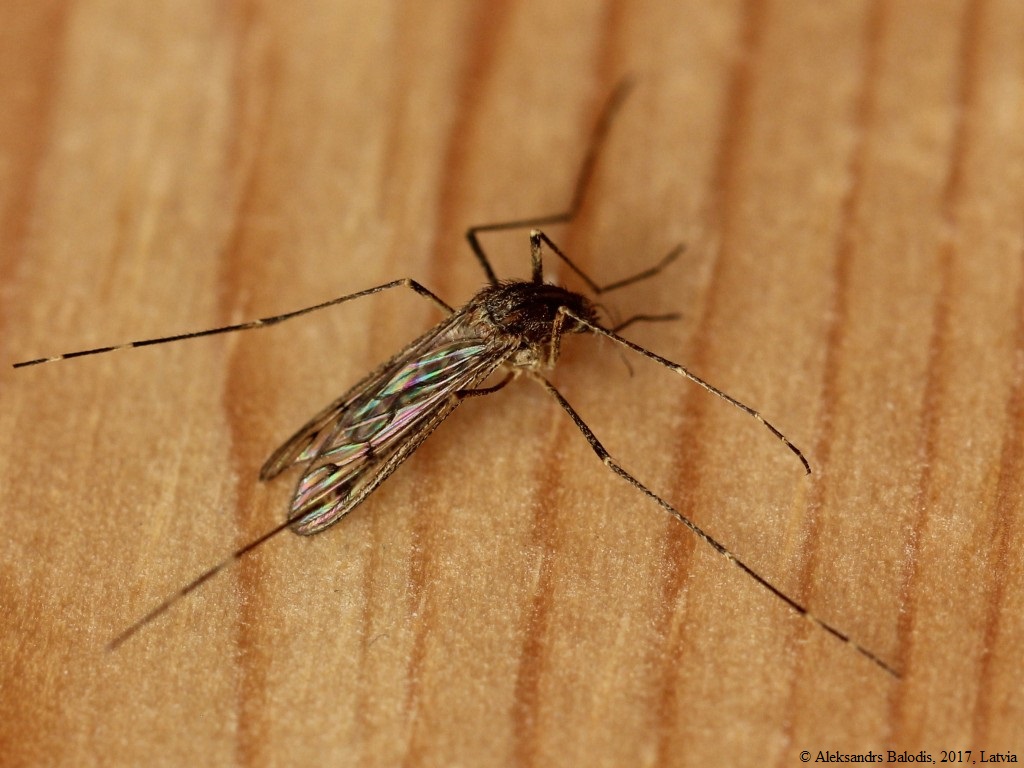
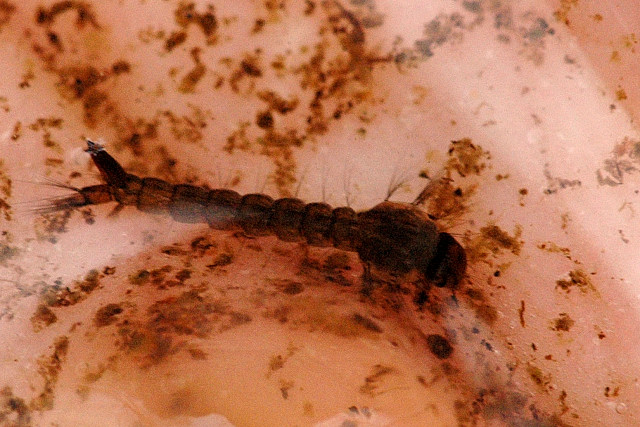
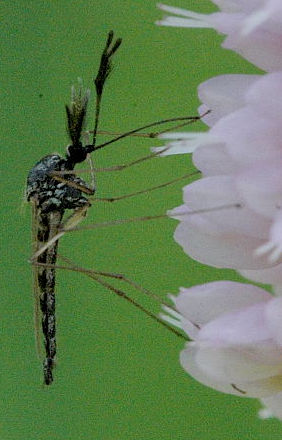
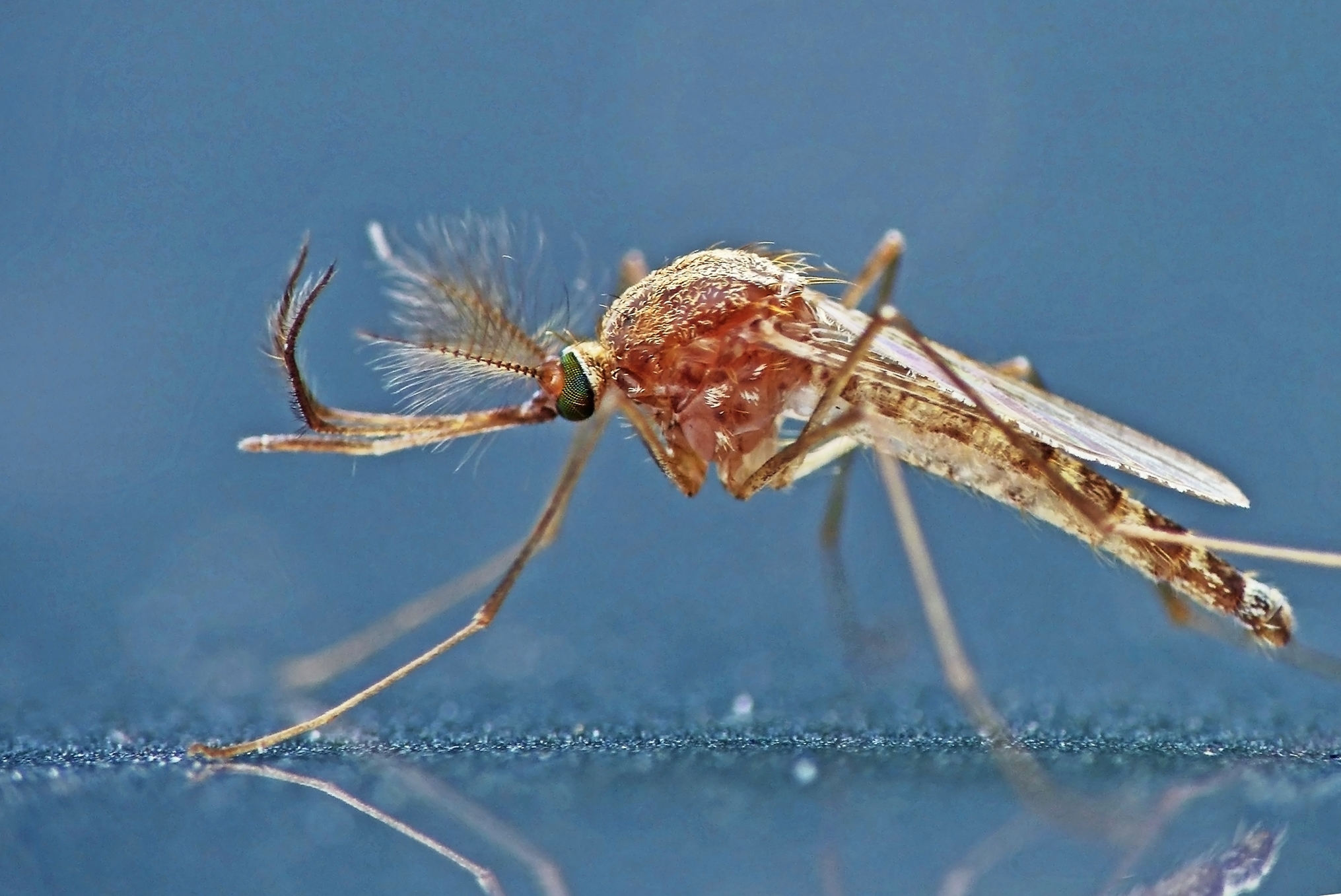
Spotted mosquito Culiseta annulata, probably the commonest biting mosquito in gardens
Above: Common gnat Culex pipiens
Left: Mosquito Ochlerotatus punctor This species needs shallow, often temporary ponds or puddles to breed
.jpg)
Highland midges Culicoides impunctatus feeding on the photographer's arm. As he notes "These insects generally attack in groups, and as the saying goes, you kill one and a thousand turn up to its funeral!"
Non-biting midges
There are about 450 species of chironomids or non-biting midges in Britain and Ireland. These insects are aquatic as larvae and occur in many small and large scale water bodies. Males have characteristic plumed antennae. They are extremely hard to identify to species, and it's very unclear how many species could be found in gardens. One very common species is the unusually large Chironomus plumosus (right).
Males aggregate in mating swarms to attract females, and these can irritate people, although the insects don't bite.
.jpg)
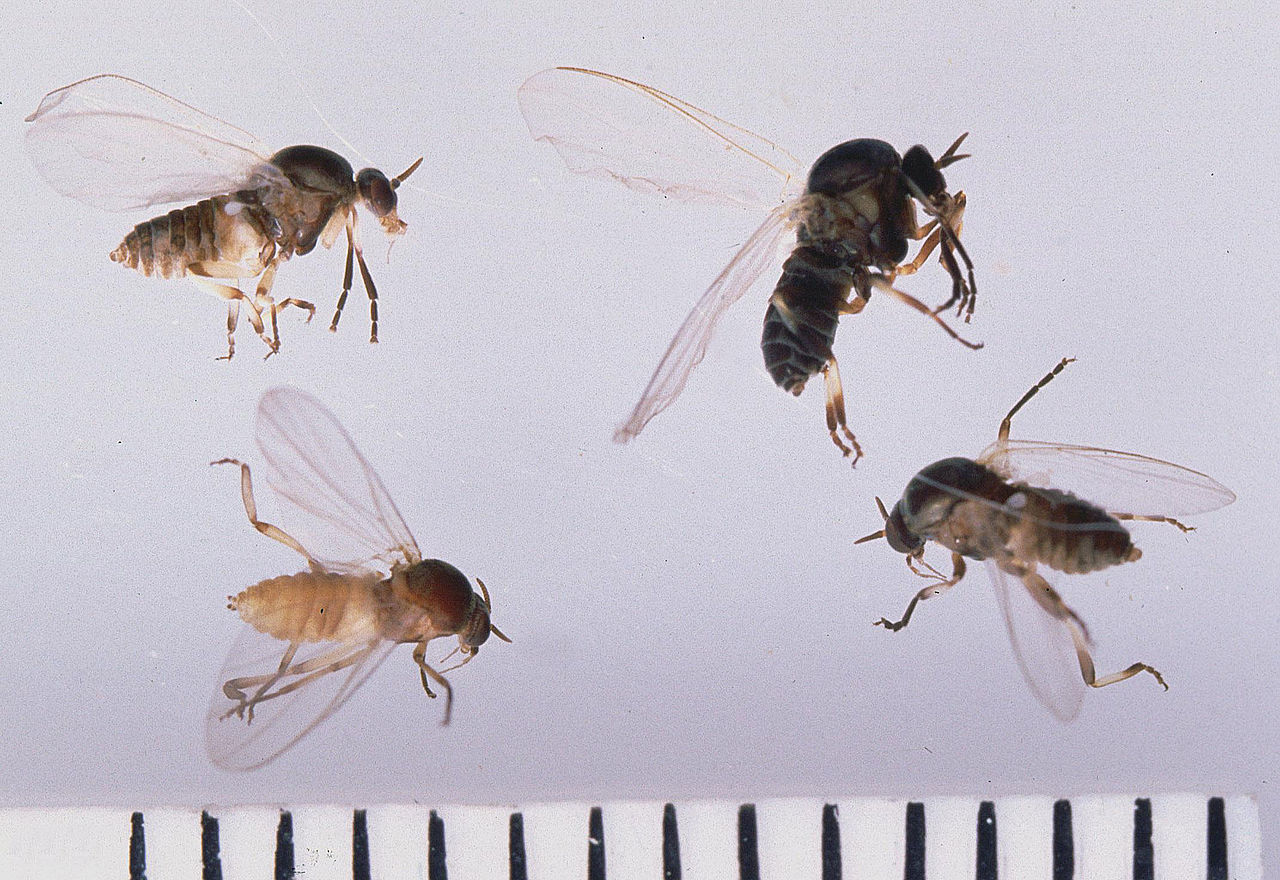
Group of black fly adults of two or more species. Scale is millimetres.
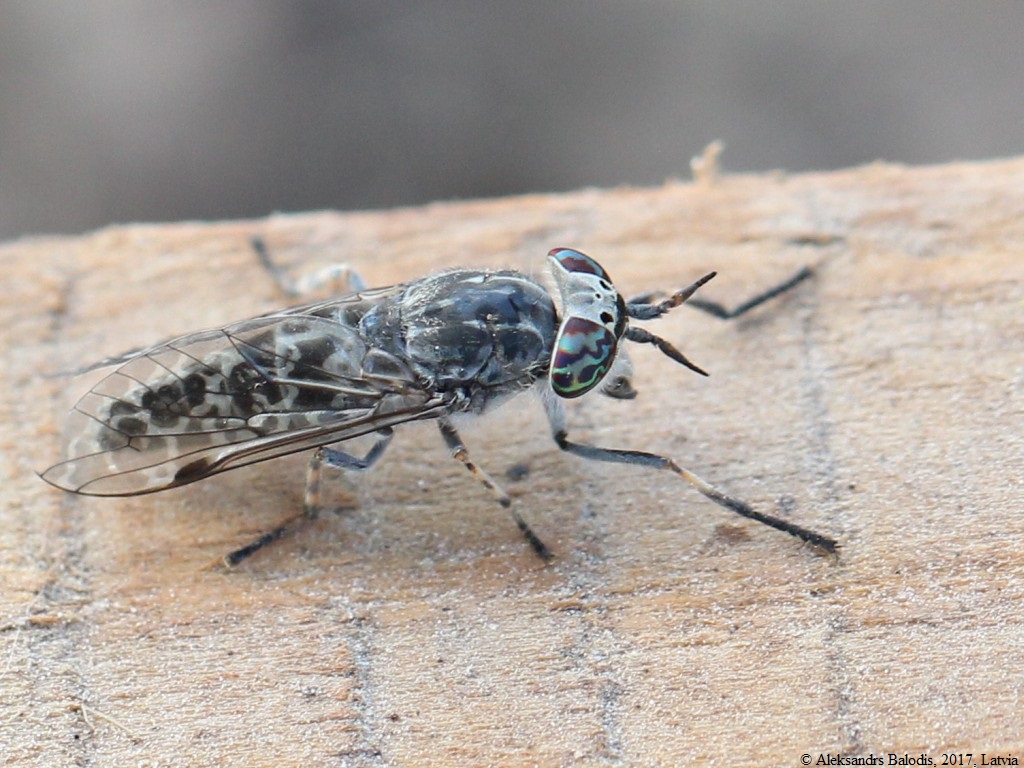
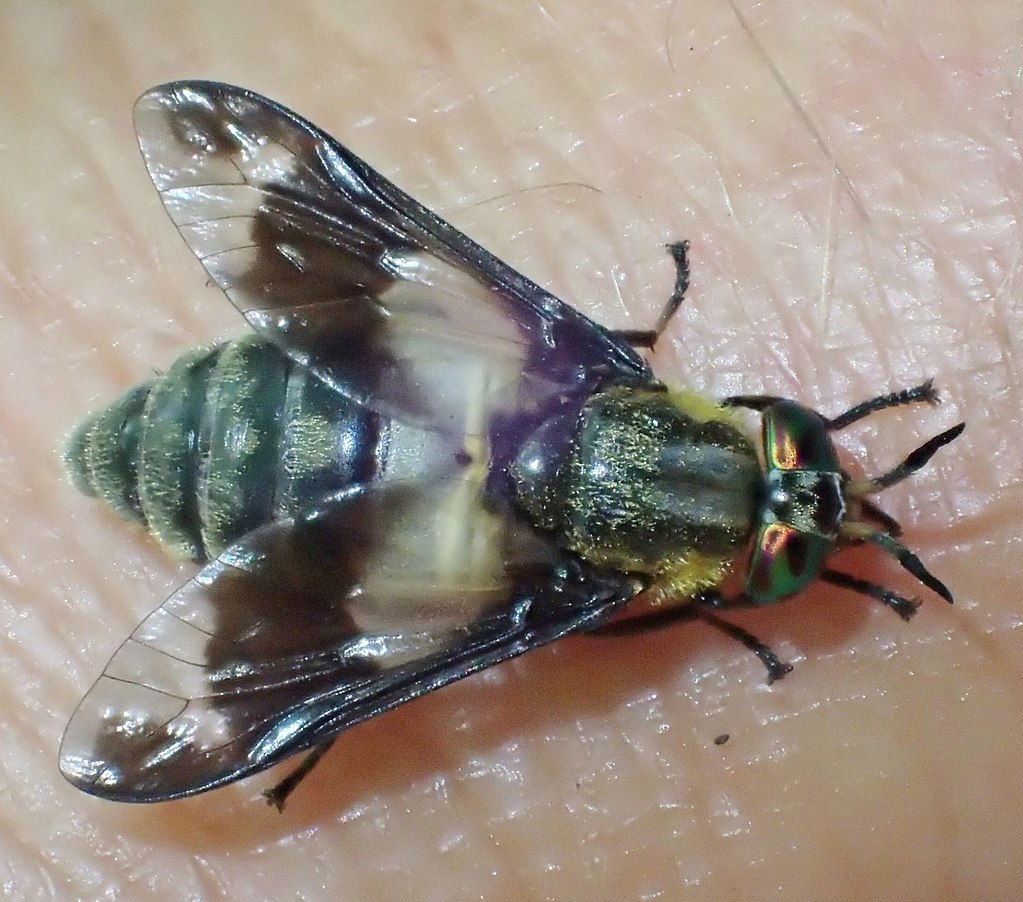
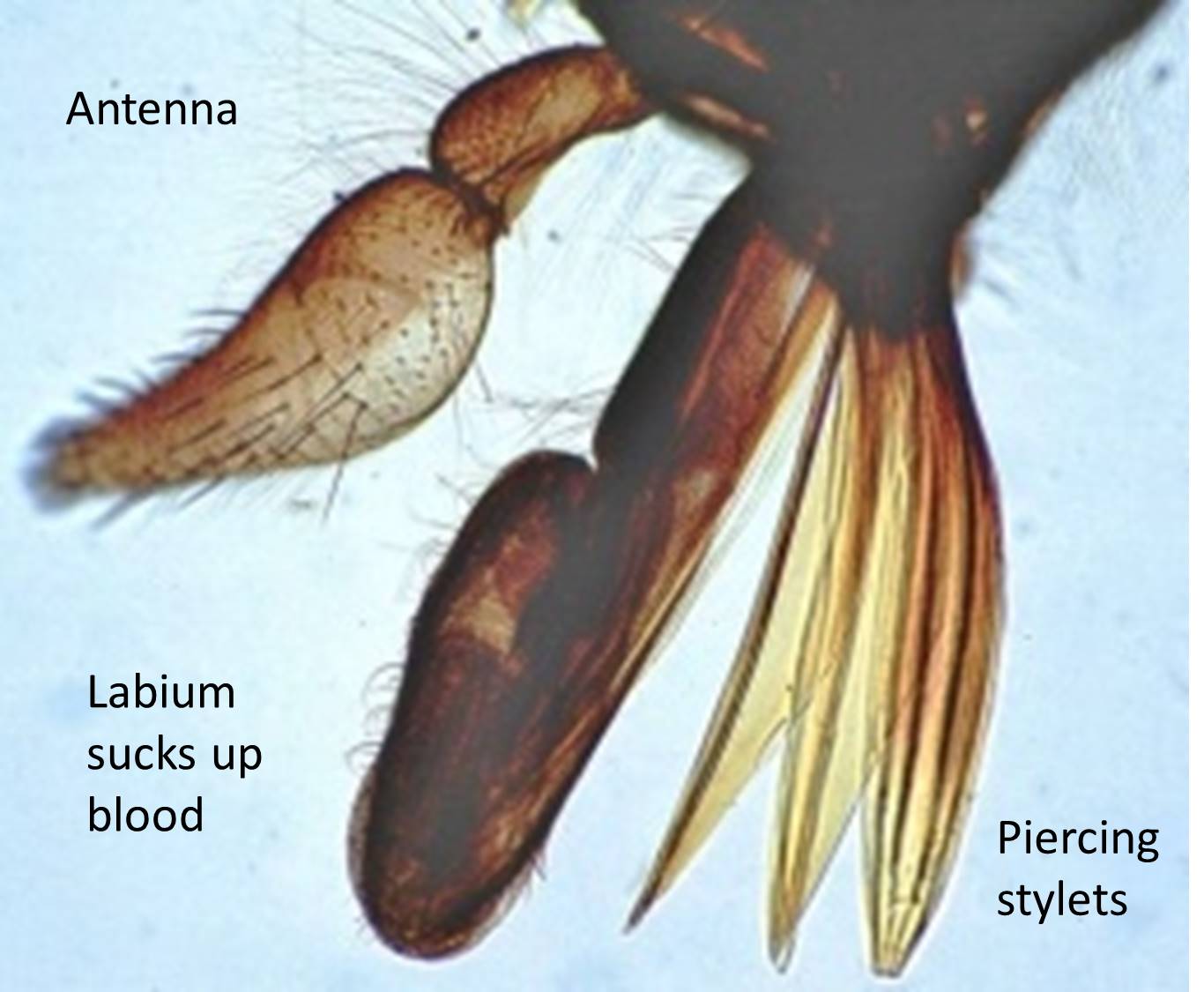
Above left: common cleg, Haematopota pluvialis Above right: horsefly Chrysops caecutiens
Left: Photomicrograph of the mouthparts of a horsefly. The scalpel-like stylets, formed of the mandibles and maxillae inflict the wound, and the pad-like labium is used to suck up the blood released.
Biology
It is the adult female biting flies that need to feed on blood in order to develop their ovaries and produce eggs. Males feed on nectar and other sweet liquids, such as honeydew. While feeding, the females secrete saliva into the bite wound to prevent the blood clotting. Biting flies are able to locate suitable animals to feed on by homing in on body heat and carbon dioxide in exhaled breath. Not all biting midges take blood from birds or mammals. Some take fluids from other insects or feed on nectar.
The larval stages of mosquitoes and black flies develop in water, where they are filter feeders that extract micro-organisms from the water. Biting midge larvae develop mainly in wet ground. Horse fly larvae also live in damp soil, where they prey mainly on earthworms.
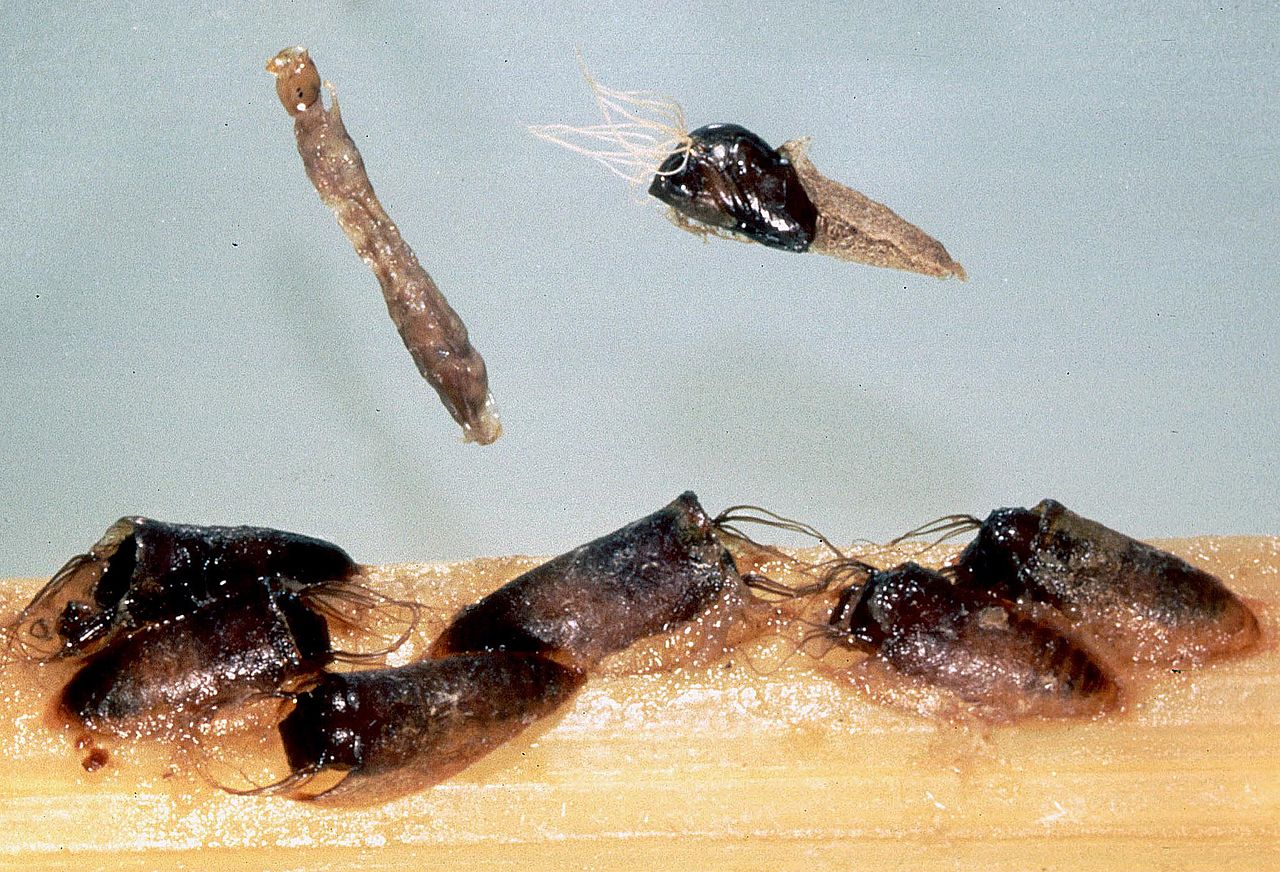
"Biting flies"and relatives
This page should be called "Stabbing" flies, because these irritating insects don't "bite" with jaws, but stab and suck blood or other fluids using highly modied mouthparts.
Several fly families have garden species that will suck blood from humans and other mammals or birds. These are the Culicidae or mosquitoes and gnats, the Ceratopogonidae or biting midges, the Simuliidae or black flies and the Tabanidae, otherwise known as horse flies and clegs. The Chironomidae are non-biting midges included here because they are related to the biting midges and blackflies, and look similar.
Species in Britain and Ireland
There are 34 species of mosquito in Britain and Ireland, 171 biting midges, 35 black flies, and 30 horse flies. Only a small minority of these species target humans when looking for a blood meal, and not many are likely to be found in gardens. This is however a pretty understudied set of species in gardens, and Jennifer Owen for example did not list any species in her book.
Mosquitoes
Mosquitoes are notorious vectors of several serious parasitic diseases, such as malaria, dengue and yellow fever. Mostly these are prevalent in the tropics, but malaria was once common in wet lowland areas of England (known as the Ague) and with climate change is likely to return.
Only female mosquitoes take blood, and they stab with very highly modified mouthparts forming a cluster of needles or stylets. This is protected in a sheath made from the labium, which folds back as the stylets penetrate the host. They inject an anticoagulant saliva in which disease organisms are transmitted.



Above Left: spotted mosquito Culiseta annulata, probably the commonest biting mosquito in gardens Centre: Mosquito Ochlerotatus punctor This species needs shallow, often temporary ponds or puddles to breed Right: Common gnat Culex pipiens
Biting midges Midges are very tiny flies, usually between one and three millimetres long. Both sexes as adults take nectar, but the females also suck blood for the protein needed for egg-laying. Their mouthparts are relatively shorter and simpler than mosquitos, and "bite" with their extended mandibles. They also inject saliva which causes an allergic response with itching and swelling. The Highland midge Culicoides impunctatus is a notorious blood sucker in Scotland; other Culicoides species can be a nuisance elsewhere. Midge larvae need moisture, but they can manage in damp soil or leaf litter.
.jpg)
Highland midges Culicoides impunctatus feeding on the photographer's arm. As he notes "These insects generally attack in groups, and as the saying goes, you kill one and a thousand turn up to its funeral!"
Non-biting midges
There are about 450 species of chironomids or non-biting midges in Britain and Ireland. These insects are aquatic as larvae and occur in many small and large scale water bodies. Males have characteristic plumed antennae. They are extremely hard to identify to species, and it's very unclear how many species could be found in gardens. One very common species is the unusually large Chironomus plumosus (right).
.jpg)

Group of black fly adults of two or more species.
Males aggregate in mating swarms to attract females, and these can irritate people, although the insects don't bite.
Black flies
Black flies are blood-feeding insects that are responsible for transmission of onchocerciasis or African river blindness. In Britain and Ireland they do not transmit disease, but the anticoagulant saliva they inject when feeding can cause intense itching and inflammation known as "black fly fever" that may need hospital treatment.
Simulium reptans, Simulium tuberosum and Simulium posticatum can inflict painful bites. The last mentioned is commonly known as the Blandford fly (common around Blandford Forum in Dorset) and there is a local brand of beer named after it, marketed as a ‘premium ale with extra bite’.


Group of black fly adults of two or more species.
Horse flies
These flies are also known as "clegs", "gadflies" and "That Ba****d" give a sharp and painful "bite" to people as well as farm animals. They are unrelated to the other flies discussed on this page and evolved their blood-sucking habits independently. Only the females take blood meals, and they stab with sharp stout piercing mouthparts. The eggs are laid on land and the larvae feed carnivorously on soil invertebrates. The commonest species include the common cleg, Haematopota pluvialis and horsefly Chrysops caecutiens.

Above left: common cleg, Haematopota pluvialis Above right: horsefly Chrysops caecutiens
Left: Photomicrograph of the mouthparts of a horsefly. The scalpel-like stylets, formed of the mandibles and maxillae inflict the wound, and the pad-like labium is used to suck up the blood released.

Biology
It is the adult female biting flies that need to feed on blood in order to develop their ovaries and produce eggs. Males feed on nectar and other sweet liquids, such as honeydew. While feeding, the females secrete saliva into the bite wound to prevent the blood clotting. Biting flies are able to locate suitable animals to feed on by homing in on body heat and carbon dioxide in exhaled breath. Not all biting midges take blood from birds or mammals. Some take fluids from other insects or feed on nectar.
The larval stages of mosquitoes and black flies develop in water, where they are filter feeders that extract micro-organisms from the water. Biting midge larvae develop mainly in wet ground. Horse fly larvae also live in damp soil, where they prey mainly on earthworms.
Aquatic larvae Left: mosquito Mosquito Ochlerotatus punctor Right: black fly larva and pupae.
Life cycle
Mosquitoes lay eggs in still water, such as ponds, ditch water and rain butts. They also use puddles, water-filled rot holes in trees and other small temporary water accumulations. These lack fish and other predators but may dry out before the larvae can complete their development. Mosquito eggs float on the water surface. When the larvae hatch, they swim in the water by flexing their bodies. They float up to the surface when they need to take in air. The pupal stage is shaped like a comma and is able to swim as actively as the larval stages. Mosquitoes can have several generations during the summer. Most species overwinter as eggs but some overwinter as adult females, which sometimes do so in buildings.
Black fly larvae require well oxygenated water, so they live in streams and rivers. The females deposit eggs on water plants or on wet mud of the river bank. The larvae attach themselves to submerged water plants, with their head ends extended into the water current. When fully grown they pupate in their larval feeding place. Adult flies emerge from the pupae underwater and float up to the surface. Black flies overwinter as eggs or larvae.
Biting midges and horse flies mostly lay their eggs in boggy ground and other places where the soil stays wet. However, larvae of Culicoides species of biting midge are semi-aquatic and develop in pond margins. Horse flies overwinter as larvae, with the pupal stage lasting for only a couple of weeks before the adult flies emerge in early to mid summer.
Role of biting flies in gardens
Biting flies can spoil the enjoyment of a garden. Mosquitoes, biting midges and black flies tend to be more active in the evening, while horse flies are active during the day. Covering up and insect repellent sprays and ointments may help keep these flies away (those containing Deet are probably the most effective) but retreating indoors may be necessary at times when biting flies are particularly active.
None of the biting flies currently found in Britain and Ireland transmit diseases such as malaria and yellow fever. However, due to climate change, it is possible that this situation will change. Ceratopogonid midges are responsible for transmitting some virus diseases of sheep and cattle, such as blue tongue disease and Schmallenberg virus in the UK.
Other sources of information
Website
Books
Bass, J. (1998) Last instar larvae and pupae of the Simuliidae of Britain and Ireland. Freshwater Biological Association
Cranston, P. S., Ramsdale, C. D., Snow, K. R. & White, G. B. (1987) Adults, larvae and pupae of British mosquitoes (Culicidae). Freshwater Biological Association
Snow, K. R. (1990) Naturalists' Handbooks 24. Mosquitoes. Richmond Publishing
Dobson,M. Pawley,S. Fletcher,M. & Powell, A. (2012) Guide to Freshwater Invertebrates Published by Freshwater Biological Association
Stubbs, A. & Drake, M. (2014) British soldierflies and their allies. British Entomological and Natural History Society
Page drafted by Andrew Halstead, reviewed by Andrew Salisbury, edited by Steve Head













